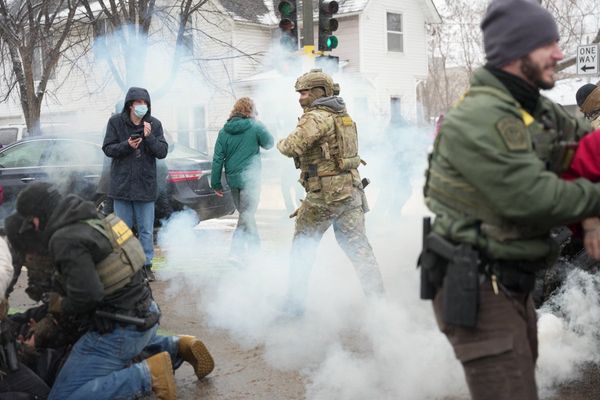Search and rescue teams racing against the clock Tuesday have still not been able to locate a submersible that vanished with five people aboard in a remote area of the Atlantic Ocean on an expedition to explore the Titanic wreck.
The mission is a complex search effort requiring expertise and equipment that spans multiple agencies, including the U.S. Coast Guard and the Navy, the Canadian armed forces and coast guard and OceanGate Expeditions, which owns and operates the missing sub, Capt. Jamie Frederick, a response coordinator with the First Coast Guard District, said at a news conference Tuesday.
Officials said the effort covers an area of about 7,600 square miles, or larger than the state of Connecticut, focusing both on surface and subsurface search.
“To date, those search efforts have not yielded any results,” Frederick said.
As of Tuesday afternoon, officials believe there are about 40 hours of emergency oxygen left in the sub based on the initial air supply of 96 hours, Frederick said.
Over the last few days, C-130 aircraft have been conducting surface searches, including with radar, and P-3 aircraft have dropped sonar buoys for subsurface detection. A vessel with specialized equipment, including a camera, has been deployed, Frederick said. A Canadian P-3 aircraft is conducting a six-hour search of the area, with more expected Tuesday evening.
Additional Canadian Coast Guard vessels are also expected to arrive, along with divers from the U.S. Navy. More private research vessels are making preparations to join the efforts, and several civilian ships have also volunteered to help, Frederick said.
A search-and-rescue mission is underway after a submersible used for tourist expeditions to view the Titanic wreck went missing in the North Atlantic.
Experts have said the mission is complex because of its remote location, and because it spans above and below the Atlantic’s waters. Though the equipment is largely coming from the East Coast, it takes time to reach the location. Frederick described the effort to deploy equipment to the scene as a “full-court press.”
But even if the vessel is located, the rescue is equally complicated, particularly given the dwindling oxygen supply. “We will do everything in our power to effect a rescue,” Frederick said.
Former U.S. Coast Guard Capt. Andrew Norris said that it’s “extraordinarily unlikely” that the five people on the submersible are saved at this point, underlining the challenges from both the isolated location and the depth. “It’s really a very novel, very, very, very challenging situation,” he said.
Norris said the main hope is that the submersible has resurfaced and could be found above the ocean. If it is stuck at the depth of the Titanic wreckage — he added that it could be caught in some of the wreck’s debris — it would be extremely difficult to extricate and bring back to the surface in the necessary time frame, he said.
According to the Coast Guard, which is leading the rescue effort out of Boston, the sub lost contact with the Canadian research vessel Polar Prince about 1 hour and 45 minutes into its dive Sunday morning, about 900 miles east of Cape Cod, Mass.
The search is unfolding in a remote location about 13,000 feet deep, officials have said.
OceanGate organized the dive and owns and operates the missing submersible. The company has been running expeditions with “citizen explorers” to the Titanic since 2021 on its 21-foot sub, called the Titan, according to its website. The trip can cost around $250,000.
OceanGate confirmed in a statement Monday that it had been unable to locate the submersible for “some time.”
“Our entire focus is on the well-being of the crew, and every step possible is being taken to bring the five crew members back safely,” the company said in a statement. “We are deeply grateful for the urgent and extensive assistance we are receiving from multiple government agencies and deep-sea companies as we seek to reestablish contact with the submersible. We pray for the safe return of the crew and passengers, and we will provide updates as they are available.”
Though officials have so far declined to release any details of those aboard, four of the five people have been identified through statements or relatives . They are Hamish Harding, chairman of Action Aviation, a Dubai-based company dealing in aviation sales and acquisitions; Paul-Henry Nargeolet, a veteran and accomplished diver with more than 30 trips to the wreck site; and Shahzada Dawood, a businessman from Pakistan, and his son, Sulaiman Dawood, were on board.
The fifth person has been identified only as the vessel’s pilot.
According to its website, OceanGate is a privately owned company in Everett, Wash., established in 2009, that operates a trio of five‑person submersibles for “site survey, scientific research, film production and exploration travel.” Its vessels can reach depths of about 13,123 feet, the company said.
The company offers an eight-day, seven-night voyage to the Titanic wreck, according to its website. The round-trip from St. John’s in Newfoundland takes “intrepid travelers” to explore the Titanic wreck. Dive expeditions can begin as early as Day 3, the company says on its website.
Harding had detailed parts of his trip across social media until he went missing Sunday. The expedition left from St. John’s on Friday, Harding wrote on his Facebook page. A “weather window” had opened up, allowing for a dive to the wreck Sunday. It was likely to be the only “manned mission” this year because of the harsh winter, he wrote.
His company, Action Aviation, also posted on Twitter about the voyage.
Harding wrote on Instagram that the team on the sub has “legendary explorers,” including Nargeolet.
Last summer, CBS news correspondent David Pogue went aboard the Titan for an expedition to the Titanic wreck and interviewed the company’s chief executive, Stockton Rush. Rush described those who join the deep sea mission as “Titaniacs” who, in some cases, mortgage their homes to pay for the trip. During the segment, Pogue read the waiver he had to sign before going aboard the Titan, which stated the “experimental” vessel is not “approved or certified by any regulatory body” and could result in physical injury, disability, emotional trauma or death.
During a tour of the Titan, Pogue described it as having about as “much room as a minivan” and containing “improvised” pieces of equipment. Rush pointed to a fixture on the ceiling that he said was acquired from Camper World, and shows a video game remote control that he said runs “the whole thing.”
Because there is no underwater GPS, a surface support vessel guides the Titan to the shipwreck by sending text messages, Pogue reported. The first attempt by Pogue’s expedition to reach the wreck resulted in the sub getting lost for a few hours because of a communication breakdown. The team’s second attempt to locate the Titanic was successful.
Rush took shots at the industry he works in a 2022 article in Maptia. “One of the jabs that gets thrown at us is: ‘Hey, you aren’t certified.’ But how can you do something new and get certified?” Rush asked. “If the rules exist for how to do it, then you are operating outside of the rules by doing something different. I think it was MacArthur who said, ‘You are remembered for the rules you break.’ We try to break the rules intelligently and intentionally.”
Rush noted that finding funding for submersibles is difficult, which is why he focuses on the Titanic expeditions. “There is only one thing underwater that billions of people know what it is, know where it is, and lots of affluent people want to go there: Titanic,” he said.
The Titanic was a British luxury liner that made its maiden voyage from Southampton, England, on April 10, 1912, bound for New York with 2,227 passengers and crew aboard. But the vessel, then the largest in the world, rammed an iceberg and sank in the early hours of April 15, killing more than 1,500 people. In September 1985, an American and French team of researchers found the liner thousands of feet below the depths of the ocean.







